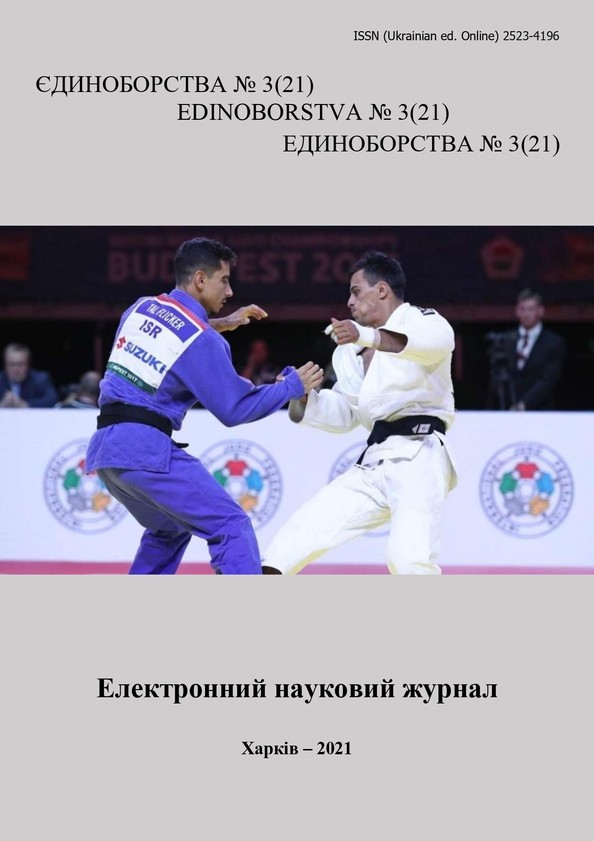Features of training students of higher educational institutions in the specialization of sports games and single combats ski training
DOI:
https://doi.org/10.15391/ed.2021-3.06Keywords:
ski training, educational process, students, sports games, martial arts, motor abilitiesAbstract
Purpose: to reveal the peculiarities of teaching students of higher educational institutions of
specializations of sports games and martial arts ski training. Material and methods. To solve the
set tasks, we conducted a study in the 2020/2021 academic year with students of the Kharkiv State
Academy of Physical Culture in the amount of 45 people, aged 18-20 years, for three weeks.
Students were taught skiing techniques both according to the traditional system (control group) and
according to the methodology developed by us (experimental groups). The time for learning the
technique of skiing in both groups was the same 15 classes of classical style and 15 classes of
skating style for 90 minutes each (according to the work program of the discipline), but the
teaching methods in the experimental groups differed. The following methods were used during the
research: theoretical analysis and generalization of scientific and methodological literature
sources, working curricula and practical experience of teachers; analysis of information on the
Internet; pedagogical observations; method of expert assessments; pedagogical experiment;
methods of mathematical statistics. Results: as a result of the study, it was found that students of the
experimental group (E1) received significantly better scores than the control group for performing the
technique of movement in the classical style, the average score - 6.30, and the control group - 5.68
points (t=3,6; p<0,01), for performing the technique of skating style score (E1) was 6.18 points, and
the control group – 5,25 points (t=5,2; p<0,01). Students of the experimental group (E2) for
performing the technique of classical movement style received an average score of 5.93, compared
with the control group - 5.68 points, no significant difference was found (p>0,05), the average score
of the group (E2) for performing skating style was 5.90 points, and the control group – 5,25 points,
which is significantly better (t=3,8; p<0,01). Conclusions. The use of different teaching methods,
taking into account sports specializations, as well as the development of leading motor skills, has
improved the learning outcomes of students of higher education specializations in sports games and
martial arts ski training. As a result of the use of simulation and special training exercises without
skis and on skis at the beginning of classes on the technique of classical and skating skiing, students
of the group significantly improved the mastery of ski training on all indicators (p<0,01–0,05).
References
Горіна, В.В., & Сидорова, Т.В. (2020). Порівняльний аналіз фізичної підготовленості студентів першого курсу ХДАФК спортивних спеціалізацій лижні гонки та східні одноборства. Єдиноборства, 2 (16), 52-60.
Гостіщев, В.М. (2010). Рівень фізичної підготовленності як чинник мотивації студентів до фізичної активності в умовах навчального процесу та у вільний час. Слобожанський науково-спортивний вісник, 1, 15-17.
Камаев, О.И. (2000). Теоретические и методические основы оптимизации системы многолетней подготовки юных лыжников-гонщиков. (Автореф. дисс. … д-ра наук по физ. восп). Харьков, Украина.
Котляр, С.М., Ажиппо, О.Ю., & Мулик, В.В. (2015). Теорія і методика викладання лижного спорту для студентів першого курсу (2-а частина): [навчально-методичний посібник]. Х. ХДАФК. 120 с.
Платонов, В.Н. (2015). Система подготовки спортсменов в олимпийском спорте. Общая теория и ее практические приложения : учебник [для тренеров] : 2 кн. Олимп. лит., Киев.
Пруднікова, М.С., & Горіна, В.В. (2011). Уровень физической подготовленности студентов второго курса кафедры зимних видов спорта, велоспорта и туризма. Слобожанський науково-спортивний вісник, 4, 23-30.
Сафонова, Ж.Б., Мараховская, О.В., & Красавина, В.Ф. (2014). Физическая активность студентов и лыжная подготовка : монография. Омск.
Сергеєв, О. (2003). Підходи до тлумачення поняття «педагогічна технологія» і класифікація педагогічних технологій. Наукові записки Кіровоградського державного педагогічного університету, 72–77.
Сидорова, Т.В., & Котляр, С.М. (2009). Особливості фізичної підготовленості студентів різних спортивних спеціалізацій. Слобожанський науково-спортивний вісник, 3, 9–123.
Holmberg, H.C. (2015). The elite cross-country skier provides unique insights into human exercise physiology. Scand. J. Med. Sci. Sports 25(Suppl. 4), 100–109. doi: 10.1111/sms.12601
Stöggl, T., Welde, B., Supej, M., Zoppirolli, C., Rolland, C.G., & Holmberg, H.C., et al. (2018).
Impact of incline, sex and level of performance on kinematics during a distance race in classical cross-country skiing. J. Sports Sci. Med. 17, 124–133.













